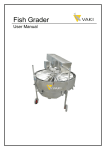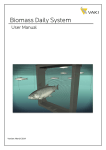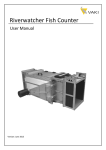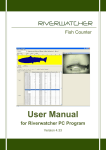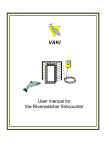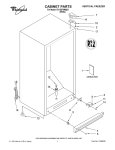Download Fish Grader
Transcript
Fish Grader User Manual 1400 Fish Grader Fish Grader Manual 2012 Contents Basic Parts ............................................................................................................................................... 2 Set up....................................................................................................................................................... 3 Control board needs to be setup .................................................................................................... 3 Adjustable legs ................................................................................................................................ 3 Adjustable Inlet cute ....................................................................................................................... 3 Motor............................................................................................................................................... 3 Control-board ...................................................................................................................................... 4 Remote control.................................................................................................................................... 4 Inlet...................................................................................................................................................... 5 Spreading the fish.................................................................................................................................... 5 Water sprinkler........................................................................................................................................ 6 Opening leveller ...................................................................................................................................... 6 Grading boxes ...................................................................................................................................... 6 Outlet................................................................................................................................................... 7 Adjustable legs .................................................................................................................................... 8 Calibrating the VAKI Grader .................................................................................................................... 8 Regular maintenance .......................................................................................................................... 9 Lubrication ....................................................................................................................................... 9 Further maintenance............................................................................................................................. 11 Changing springs and bearings .......................................................................................................... 11 Grader Quality ....................................................................................................................................... 13 1 Fish Grader Manual 2012 Basic Parts The VAKI-1400 grader is designed to sort live fish, smolt, juveniles and fry. The grader carousel is hexadecagon and has sixteen boxes that rotate within the grader. As each box passes over an outlet the grading gap (opening) in the bottom of the box is automatically increased to a preselected size. The grading gaps can be set from fully closed up to a maximum 45mm wide. The fish are graded by thickness. The standard grader has 4 outlets and a single fish inlet. Fish can be pumped or netted into the grader. The inlet can be angled to increase or slow down the fish flow into the grader and the inlet has an integrated de-watering box. There is a 360° adjustment in the direction of the outlets from the grader. Variable speed The VAKI grader has speed regulator which can adjust the speed from 5 - 12 rpm. Mains power supply by either single or three phases. Fish stay in water because water flows into the rotating grading boxes from the integrated sprinkler system. The fish remain in water at all times during the grading and pass easily through the outlet pipes. The Grader is constructed from stainless steel. It has height adjustable legs and is fully portable on rubber wheels. Grading carousel Central well Grading boxes Motor De water/additional water inlet integrated sprinkler sprinkler Control of inlet indication Level adjustment Outlet Adjustable legs 2 Fish Grader Manual 2012 Set up Control board needs to be setup The control board needs to be placed and fastened. The main board is fastened with two bolts and two rows. Make sure that the electric cables don´t fall into the moving grader. Adjustable legs Adjustable legs are lying on the bottom of the box. Adjustable Inlet cute Frame needs to be fastened in to the cross. It is fastened with bolts through the frame and the cross ends. Motor The VAKI grader is driven from a geared motor. The motor is fitted with a regulator to control the speed from 5 to 12 rpm. It is best practice to start up the grader at low speed. The grader should be connected to an ordinary 230 volts, AC electrical supply (2 ampere), which is converted internally to threephased current for the motor by the transformer. As an option a 110-volt version can be supplied. 3 Fish Grader Manual 2012 Control-board Control Board has eight buttons. The big red rotation button on the bottom of left sight is the main power switch and can only be turned on if the cabinet is closed. The green button is the start button. The red button (yellow light) shows if there is a power on the grader or not. The red button stops the action. The gray button is rotation button that controls the (rotation) speed. On the front side there are three buttons, one black who decides which linear actuator (1, 2 or 3) is active that opens the grading gaps. The green buttons open/close the grading gaps. This can be adjusted while the grader is running. Opening the control board: Turn off the main power switch and open the control cabinet. It will not open without the main switch turned off. Remote control A wire remote control is optional and highly recommended. With the remote control it’s possible to start and stop the grader staying at ground level, even though the grader is elevated. 4 Fish Grader Manual 2012 Inlet To achieve the best results and highest capacity it is important to spread the fish evenly, uniformly and at a steady rate through the grader. Up-well inlet: Fish can be transferred into the grader through the up-well or netted into the inlet hopper. When using a fish pump to transfer fish to the grader it is important to ensure an even flow of fish and water. Uneven delivery of fish to the grader can cause inaccurate grading as the number of fish may exceed the capacity limits (e.g. rotation speed). The diameter of the inlet is 4”. De-water outlet: Additional dewatering may be required if larger pumps or very small fish are being used. Spreading the fish The steepness of the slide helps to control the speed and flow of fish into the grading boxes. The steepness can be changed by dragging the slide up/down a steepness bar. “Flow direction controller” leads the smolt to the centre of the grader. Centrifugal force pushes the fish to the outer diameter of the grader. 5 Fish Grader Manual 2012 Water sprinkler Water flows into the rotating grading boxes from the integrated sprinkler system. The fish remain in water at all times during the grading and pass easily through the outlet pipes. Opening leveller The lower parts of the grading boxes are opened by a directional cam. The position of the cam, and thus the opening of the grading compartment are controlled by a leveller driven by a linear actuator. There is one actuator for each grade which position decides the opening. Cam Opening leveller Grading boxes The grading gaps of the grading boxes can be adjusted from fully closed up to 50 mm wide The length of the boxes is fixed at 440 mm on the larger (140) version. The length of box and 45 mm width is the limit to the maximum thickness of fish that can be graded. 6 Fish Grader Manual 2012 Linear actuators which are controlled by green buttons on the control board open and close the grading gaps. Grading scale is located next to each pump and shows the mm opening of the grading gap. Raise and lower the linear leveller to adjust the grading gaps in bottom of the grading boxes. Outlet Fixed under the rotating grading boxes are the outlet chutes. The outlets collect the graded fish and direct them into pipes away from the grader. The standard outlets are 160 mm tubes (a reduction can bring the size to 110, 80 or 60 mm). There are four outlets on the standard machine. 7 Fish Grader Manual 2012 Adjustable legs The height of the grader can be adjusted by approximately +/- 1 meter by releasing the wing nuts and sliding the leg profile up or down to desired position. It is of outmost importance that the grader is levelled and the wing nuts tightened to ensure the stability of the grader. To prevent instability, make sure that the total length is no longer than 170cm. If the grader needs to be raised more, VAKI recommend users to insert platform under the grader. If the grader is installed on a platform or elevated from the floor level by any means it should be secured by straps or other means preventing it from tilting. Maximum length 170cm. Calibrating the VAKI Grader The VAKI grader is calibrated at the factory. However in time should the calibration need resetting if possible this should be carried out by an authorised VAKI service agent. The calibration procedure is to ensure all boxes open identically for each grade size. Each of the grading boxes must be checked and reset, if required, at the same position on the grader. It is therefore preferable to carry out the calibration in a position where you can either manually or using the motor rotate the grader to the point you are going to carry out the calibration. 8 Fish Grader Manual 2012 In this sample we use 11 mm opening as the calibration setting, but of course any size above 5 mm can be used. Step 1. The opening for a grade is set to 11 mm. Using a suitable gauge (e.g.11mm drill bit to set opening in box to 11mm) set the first box to a fixed size by running the cam through a leveller. Stop the motor, secure the position of the arm with the white plastic wheel, e.g. with a spring pulling against the braking direction of the bearing. Then position the 11 mm gauge in the opening and release the two bolts on the arm that presses against the cam. Let the 19 mm bearing touch the cam firmly without changing the opening and tighten the two bolts. Step 2. Repeat for all boxes ensuring that checking and adjusting the grading gap takes place at the exact same point of the round. Step 3. Evaluate the gap setting and reset the gap opening scale. To reset the gap opening scale: loosen up the bolts on the scale move the scale to right position and fastened again. Regular maintenance Lubrication It is important to lubricate bearings and springs regularly, every two months and also when the time between grading is long. Bearings and springs need to be lubricated with food certified grease that has high tolerance for cold water/sea. No 1. Open casing 1) 2) 3) 4) 5) 6) 2. Lubricate bearing 3. Lubricate the spring 4. Rotate comb 5. Remove extra grease 6. Put comb back to place. Are all boxes lubricated? Yes 8. Close casing The casings are opened by losing up the four bolts. (It is not necessary remove the bolts) Lubricate the bearings with grease pump. Lubricate the spring(s) with pencil. The springs are located in front of each cam. Rotate the cam to spread the grease. Remove the extra grease. Verify that cam is in right position. If the cam is not in the right position compared to placement on the grader the grader will not run. 7) Have all the sixteen cams been lubricated? Yes/No. No: Repeat until all springs and bearings have been lubricated. Yes, lubricating finished. 8) Casing/cover put back on the grader. 9 Fish Grader Manual Needed for Lubrication: brush, grease, grease pump, Allen key number six. 10 2012 Fish Grader Manual 2012 Further maintenance Changing springs and bearings Long term usage of the grader will cause fatigue breaks. By replacing the components that takes the most stress it’s possible to lengthen the grader lifetime. 4. Change springs if needed. 2. Disconect the motor. 8. Close casing No 1. Open casing. 3. Losen up 4 combs 5. Change bearings if needed. 7.fasten 4 combs Have all 16 combs been changed? Yes 9. Connect the motor. 6.Change washeres if needed. 1) Disconnect the motor. Motor is disconnected by pulling the pin out of its center. 2) Open the cover. The casings are opened by losing up the four bolts on sides of the casing. 3) It’s ideal to work with four cams at the time; it saves time and doesn’t make the grader misalignment. To remove the cam and the spring from the grader it´s necessarily to loosen up two bolts which are located under the grader, connected to the cam. 4) Change spring. 5) The bearings reduce friction. 6) Replace washers. 7) It is easier to put a spring back the place when the cam placed in front of the cam is not placed. 8) Cover/casing closed by sliding it under the half loose screws. Screws are then fastened. 9) The motor is activated by putting the pin back to place. 11 Fish Grader Manual 12 2012 Fish Grader Manual 2012 Grader Quality The VAKI-grader is designed to sort live fish, smolt, juveniles and fry based on its thickness. The grader is hexadecagon and has sixteen boxes that rotate within the grader. As each box passes over an outlet the grading gap (opening) in the bottom of the box is automatically increased to a preselected size. The grading gaps can be set from fully closed up to a maximum 50mm wide. The fish are graded by thickness. The standard grader has 4 outlets and a single fish inlet. To follow the grader quality it´s best to get to know the mean and the standard deviation of original group. It’s easy and fast to take weight samples and from that information it’s possible to decide the grading gaps opening and estimate the percent of fish in each grading group. When the grader is running it’s useful to take a sample from each size group and measure the weight, thickness and length of the fish. Then compare the results to the gaps settings and earlier weight results. Materials needed to perform quality assurance are: digital caliper, scales, parameter, excel document, paper pencil, paper towel, anesthesia. 13














